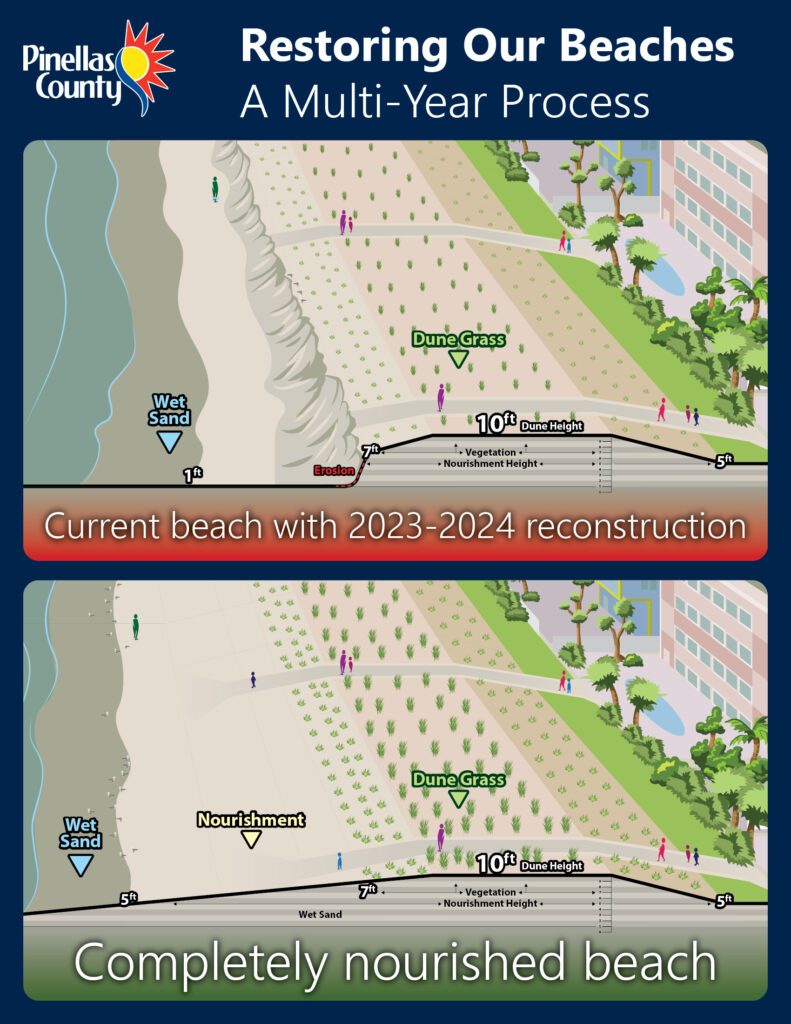Emergency Beach Erosion Control Project Frequently Asked Questions
Why is the project necessary?
Hurricane Idalia caused severe erosion on Pinellas beaches, washing away dunes and as much as four feet of the beach’s height in some places. Pinellas County has hired a contractor to build dunes to protect homes and infrastructure from future storms. Without the dunes, beachfront properties would be directly exposed to storm surge, which is an extremely destructive wall of water pushed by storm winds.
How soon will the emergency beach reconstruction be completed?
We have completed several segments and are actively working on or planning the rest. Please view the map and schedule on this page for segments under construction or planned.
My access to the beach has been blocked by sand. How do I access the beach?
If you had an access path before, you should still have it now. There may be a slope to cross over between vegetated dunes. In some cases, the County is adjusting the slope to make the access points easier to use. Some municipalities and property owners are using stakes and ropes to mark off the pathways. It is important to use the access points because walking over the other parts of the dune can damage the dune and plants and decrease their ability to protect us from the sea. Click on the image below for a larger view.

Will the project be completed before the next hurricane season?
Yes, the emergency beach stabilization project is scheduled to be completed well before next hurricane season.
Why is there so little beach left between the dunes and water?
This critical project has two phases, starting with the emergency protection phase and, in a few years, the second phase will be full nourishment. Nourishment will bring the beach height halfway up the dunes (five feet above sea level). For the next two years, while the County designs and permits the nourishment phase, these dunes will be all that stands between the beachfront properties and the Gulf of Mexico. You’ll notice that the vegetation planting on the dunes starts several feet up the dune (7 feet above sea level). We expect the bottom several feet of the dunes to end up on the beach. That sand provides a buffer for the new plants to establish themselves without being washed away by high tides and storm.
Why do the dunes need to be 10 feet high?
The dunes were constructed in anticipation of the nourishment project bringing the beach back to a 5-foot elevation. Anything less would not provide sufficient protection during the next two hurricane seasons while the nourishment project is being designed and permitted.
If I don’t like the dune behind my property, can I deconstruct it or extend my landscaping beyond my property line?
No, this would be a violation of state law and would endanger your neighbors by decreasing the protective power of the dunes.
Where is the sand for this project coming from?
The sand for this project has been sourced from state-approved mines. The sand is clean and tested to ensure it is compatible with our beaches.
How much does a load of sand cost?
The sand for this project costs $90 per ton. This project is being paid for by Tourist Development Tax, which is a small tax charged every time someone stays at a hotel in Pinellas County. For more information visit FromVisitorsWithLove.com.
How will the dunes be maintained?
The dunes do not require any maintenance except for some watering while the vegetation is getting established. However, to ensure the dunes do not need to be replanted or reconstructed, residents and visitors must stay off the dunes and only use the designated pathways.
What is the penalty for walking on dunes with plants?
Walking through a dune and crushing vegetation is a violation of state law. Fines or penalties would be dependent on the amount of damage.
What happens if the vegetation dies?
Once planted, the dune vegetation is under warranty for 90 days. The contractor is required to ensure that 90% of the plants survive. The contractor will have to re-plant any plants that do not survive 90 days.
If there is existing vegetation, like invasive species, will those be removed?
Invasive species removal is not part of this project. Each spring/summer, we do give away sea oats for volunteer planting events so be on the lookout for those announcements.
How much does the project cost and who is paying for it?
The emergency project has cost about $26 million to date, and future segments are planned. It is being paid for by the Tourist Development Tax. For more information visit FromVisitorsWithLove.com.